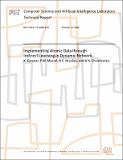Implementing Atomic Data through Indirect Learning in Dynamic Network
Author(s)
Konwar, K.; Musial, P.M.; Nicolau, N.C.; Shvartsman., A.A.
DownloadMIT-CSAIL-TR-2006-070.pdf (470.8Kb)
Additional downloads
Other Contributors
Theory of Computation
Advisor
Nancy Lynch
Metadata
Show full item recordAbstract
Developing middleware services for dynamic distributed systems, e.g., ad-hoc networks, is a challenging task given that suchservices must deal with communicating devices that may join and leave the system, and fail or experience arbitrary delays. Algorithmsdeveloped for static settings are often not usable in dynamic settings because they rely on (logical) all-to-all connectivityor assume underlying routing protocols, which may be unfeasible in highly dynamic settings. This paper explores the indirectlearning approach to information dissemination within a dynamic distributed data service. The indirect learning scheme is usedto improve the liveness of the atomic read/write object service in the settings with uncertain connectivity. The service is formallyproved to be correct, i.e., the atomicity of the objects is guaranteed in all executions. Conditional analysis of the performanceof the new service is presented. This analysis has the potential of being generalized to other similar dynamic algorithms. Underthe assumption that the network is connected, and assuming reasonable timing conditions, the bounds on the duration of theread/write operations of the new service are calculated. Finally, the paper proposes a deployment strategy where indirect learningleads to an improvement in communication costs relative to a previous solution.
Date issued
2006-10-12Other identifiers
MIT-CSAIL-TR-2006-070
Series/Report no.
Massachusetts Institute of Technology Computer Science and Artificial Intelligence Laboratory